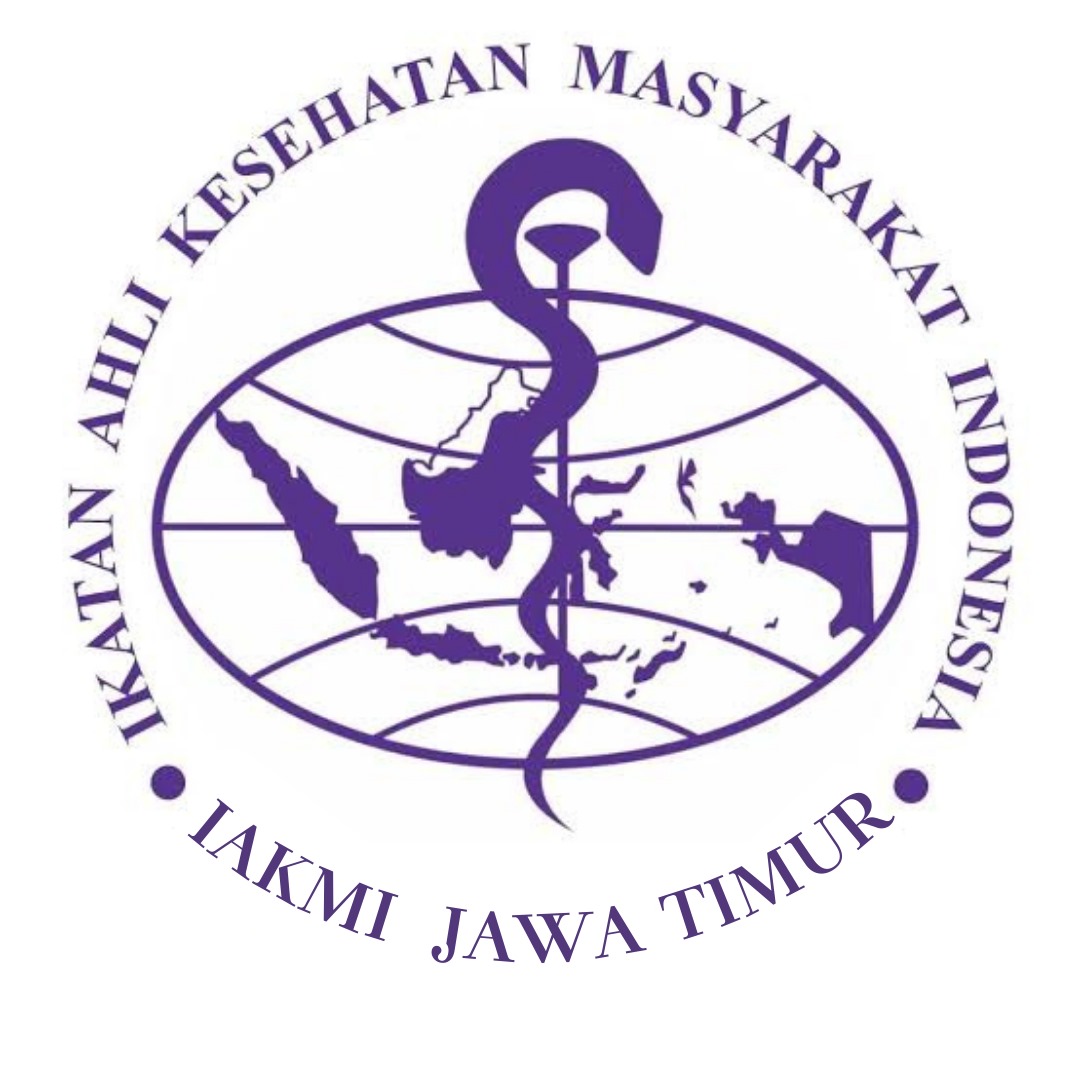Analisis Panjang Badan Lahir dan Berat Badan Lahir terhadap Wasting pada Baduta di Kota Surabaya

Unduhan
Latar Belakang: Wasting merupakan permasalahan kesehatan masyarakat yang masih signifikan di Surabaya. Wasting dapat menghambat pencapaian optimal pada periode emas masa pertumbuhan anak di seribu hari pertama kehidupan yang menentukan kualitas sumber daya manusia (SDM) Indonesia di waktu yang akan datang. Kondisi anak seperti berat badan lahir rendah dan panjang badan lahir rendah dapat meningkatkan risiko terjadinya wasting.
Tujuan: Mengetahui adanya hubungan antara panjang badan lahir dan berat badan lahir dengan kejadian wasting pada baduta di Kota Surabaya.
Metode: Desain penelitian cross sectional dengan menggunakan data sekunder. Jumlah sampel sebanyak 160 baduta di wilayah kerja Puskesmas Putat Jaya, Puskesmas Sememi, Puskesmas Tanah Kalikedinding, dan Puskesmas Bangkingan Surabaya yang diperoleh melalui concecutive sampling. Analsis data menggunakan uji korelasi Pearson.
Hasil: Proporsi baduta wasting sebesar 13,8%. Hasil penelitian menunjukan bahwa ada hubungan antara berat badan lahir (p= 0,030) dengan kejadian wasting pada baduta di Kota Surabaya. Tidak ditemukan adanya hubungan antara panjang badan lahir dengan kejadian wasting (p= 0,675).
Kesimpulan: Terdapat hubungan antara berat badan lahir dengan kejadian wasting pada baduta di Kota Surabaya dan panjang badan lahir tidak berhubungan dengan terjadinya wasting.
Abbas, F. et al. (2021) ‘Impact of children born with low birth weight on stunting and wasting in Sindh province of Pakistan: a propensity score matching approach’, Scientific Reports, 11(1), p. 19932. Available at: https://doi.org/10.1038/s41598-021-98924-7.
Aboagye, R.G. et al. (2022) ‘Birth weight and nutritional status of children under five in sub-Saharan Africa’, PLOS ONE. Edited by S. Kumar, 17(6), p. e0269279. Available at: https://doi.org/10.1371/journal.pone.0269279.
Akombi, B. et al. (2017) ‘Stunting, Wasting and Underweight in Sub-Saharan Africa: A Systematic Review’, International Journal of Environmental Research and Public Health, 14(8), p. 863. Available at: https://doi.org/10.3390/ijerph14080863.
Andreanetta, P.T. et al. (2022) ‘Hubungan Berat Badan Lahir Dengan Status Gizi Dan Perkembangan Anak Usia 6 – 60 Bulan’, E-Jurnal Medika Udayana, 11(9), p. 34. Available at: https://doi.org/10.24843/MU.2022.V11.i9.P07.
Anggraeni, Z.E.Y. et al. (2020) ‘Hubungan Berat Badan Lahir, Panjang Badan Lahir dan Jenis Kelamin dengan Kejadian Stunting’, The Indonesian Journal of Health Science, 12(1), pp. 51–56. Available at: https://doi.org/10.32528/ijhs.v12i1.4856.
Astuti, L. et al. (2020) Bunga Rampai Wasting Bencana Bagi Sumber Daya Manusia Tantangan Indonesia Maju Tahun 2045. Jakarta: Lembaga Penerbit Badan Penelitian dan Pengembangan.
Badriyah, L. (2019) ‘Hubungan Karakteristik Keluarga, Ekonomi, dan Faktor Lain dengan Stunting, Wasting dan Underweight pada Anak Usia 6-23 bulan di Indonesia’, Jurnal Ilmiah Kesehatan, 18(1), pp. 26–32. Available at: https://doi.org/10.33221/jikes.v18i1.201.
Destarina, R. (2018) ‘Faktor Risiko Anemia Ibu Hamil Terhadap Panjang Badan Lahir Pendek Di Puskesmas Sentolo 1 Kulon Progo D.I.Yogyakarta’, GIZI INDONESIA Journal of The Indonesian Nutrition Association, 41(1). Available at: https://doi.org/https://doi.org/10.36457/gizindo.v41i1.250.
Devi Akib, R., Syahriani and St. Nurbaya (2022) ‘Hubungan Panjang Badan Lahir dan Berat Badan Lahir Dengan Terjadinya Stunting Pada Balita Didaerah Lokus dan Non Lokus Stunting Dikabupaten Sidrap’, Sehat Rakyat: Jurnal Kesehatan Masyarakat, 1(3), pp. 267–272. Available at: https://doi.org/10.54259/sehatrakyat.v1i3.1080.
Hamal, D.K., Nursyarofah, N. and Qualifa, A. (2021) ‘Jenis Kelamin Dan Panjang Badan Lahir Sebagai Faktor Kejadian Stunting Di Kabupaten Majene Provinsi Sulawesi Barat Tahun 2018 (Analisis Data Riskesdas 2018)’, ARKESMAS (Arsip Kesehatan Masyarakat), 6(2), pp. 1–7. Available at: https://doi.org/10.22236/arkesmas.v6i2.7685.
Harding, K.L., Aguayo, V.M. and Webb, P. (2018) ‘Birthweight and feeding practices are associated with child growth outcomes in South Asia’, Maternal & Child Nutrition, 14(S4). Available at: https://doi.org/10.1111/mcn.12650.
Hidayati, N. (2021) ‘Berat Badan dan Panjang Badan Lahir Meningkatkan Kejadian Stunting’, Jurnal Ilmiah Kesehatan, 14(1), pp. 8–17. Available at: https://doi.org/https://doi.org/10.48144/jiks.v14i1.524.
Indriani, D. (2018) Analisis Multilevel Determinan Stunting dan Wasting Balita di Kabupaten Nganjuk Provinsi Jawa Timur. Universitas Sebelas Maret. Available at: https://digilib.uns.ac.id/dokumen/detail/58546/.
Judiono, J. et al. (2023) ‘Faktor Determinan Panjang Badan Bayi Lahir Pendek sebagai Faktor Risiko Stunting di Jawa Barat’, Amerta Nutrition, 7(2), pp. 240–247. Available at: https://doi.org/10.20473/amnt.v7i2.2023.240-247.
Karinasari, I. and Badriyah, T. (2020) ‘Deteksi Dini Penyakit Iugr (Intra Uterine Growth Retriction) Dengan Metode Svm (Support Vector Machine)’, Kumpulan Jurnal Ilmu Komputer (KLIK), 7(2), pp. 176–186. Available at: https://doi.org/http://dx.doi.org/10.20527/klik.v7i2.321.
Kemenkes RI (2020) Peraturan Menteri Kesehatan Republik Indonesia Nomor 2 Tahun 2020 Tentang Standar Antropometri Anak. Jakarta: Kemenkes RI.
Kemenkes RI (2021) Hasil Studi Status Gizi Indonesia (SSGI) Tingkat Nasional, Provinsi, dan Kabupaten/Kota Tahun 2021. Jakarta: Kementerian Kesehatan RI.
Lukman, T.N.E. et al. (2021) ‘Birth Weight and Length Associated with Stunting among Children Under-Five in Indonesia’, Jurnal Gizi Pangan, 16(Supply 1), pp. 99–108. Available at: https://journal.ipb.ac.id/index.php/jgizipangan/issue/view/2809.
McDonald, C.M. et al. (2012) ‘Predictors of stunting, wasting and underweight among Tanzanian children born to HIV-infected women’, European Journal of Clinical Nutrition, 66(11), pp. 1265–1276. Available at: https://doi.org/10.1038/ejcn.2012.136.
Muliyati, H. et al. (2021) ‘Analisis faktor kejadian wasting pada anak balita 12-59 bulan di Puskesmas Bulili Kota Palu: Studi cross sectional’, AcTion: Aceh Nutrition Journal, 6(2), p. 111. Available at: https://doi.org/10.30867/action.v6i2.345.
Murti, F.C., Suryati, S. and Oktavianto, E. (2020) ‘Hubungan Berat Badan Lahir Rendah (Bblr)Dengan Kejadian Stunting Pada Balita Usia 2-5 Tahun Di Desa Umbulrejo Kecamatan Ponjong Kabupaten Gunung Kidul’, Jurnal Ilmiah Kesehatan Keperawatan, 16(2), p. 52. Available at: https://doi.org/10.26753/jikk.v16i2.419.
Nadhiroh, S.R., Ayuningtyas, H. and Salsabil, I.S. (2024) ‘Linear growth determinants of under two years old children in Surabaya, Indonesia’, Clinical Epidemiology and Global Health, 27, p. 101605. Available at: https://doi.org/10.1016/j.cegh.2024.101605.
Ntenda, P.A.M. (2019) ‘Association of low birth weight with undernutrition in preschool-aged children in Malawi’, Nutrition Journal, 18(1), p. 51. Available at: https://doi.org/10.1186/s12937-019-0477-8.
Putri, B. (2024) Hubungan Berat Badan Lahir, Riwayat Pemberian ASI Eksklusif dan Pemberian Makanan Pendamping ASI dengan Kejadian Wasting di Wilayah Kerja Puskesmas Pegambiran Kota Padang Tahun 2023. Universitas Andalas. Available at: http://scholar.unand.ac.id/464618/.
Rahman, M.S. et al. (2016) ‘Association of Low-Birth Weight with Malnutrition in Children under Five Years in Bangladesh: Do Mother’s Education, Socio-Economic Status, and Birth Interval Matter?’, PLOS ONE. Edited by F.M.A. Islam, 11(6), p. e0157814. Available at: https://doi.org/10.1371/journal.pone.0157814.
Rahmawati, L.A., Ranggauni Hardy, F. and Anggraeni, A. (2020) ‘Faktor-Faktor yang Berhubungan dengan Stunting Sangat Pendek dan Pendek pada Anak Usia 24-59 Bulan di Kecamatan Sawah Besar’, Jurnal Ilmiah Kesehatan MasyarakaT : Media Komunikasi Komunitas Kesehatan Masyarakat, 12(2), pp. 68–78. Available at: https://doi.org/10.52022/jikm.v12i2.36.
Rahmawati, V.E. (2020) ‘Hubungan Panjang Badan Lahir Dengan Kejadian Stunting Pada Anak Balita Usia 0-59 Bulan Di Kabupaten Jombang’, Jurnal Kebidanan, 9(2), pp. 44–48. Available at: https://doi.org/10.47560/keb.v9i2.250.
Ruaida, N. (2018) ‘Gerakan 1000 Hari Pertama Kehidupan Mencegah Terjadinya Stunting (Gizi Pendek) Di Indonesia’, Global Health Science, 3(2). Available at: https://doi.org/http://dx.doi.org/10.33846/ghs.v3i2.245.
Sawitri, P. (2019) ‘Pengaruh Pendidikan Kesehatan Menggunakan Audiovisual Terhadap Pengetahuan Tentang Tablet Fe Pada Remaja Putri Kelas X Di’. Available at: http://repository.umkla.ac.id/id/eprint/1006 (Accessed: 26 January 2024).
Septikasari, M. and Septiyaningsih, R. (2016) ‘Faktor Yang Mempengaruhi Orang Tua Dalam Pemenuhan Nutrisi Balita Gizi Kurang’, Jurnal Kesehatan Al-Irsyad, 9(2), pp. 25–30. Available at: https://jka.universitasalirsyad.ac.id/index.php/jka/article/view/55.
Utami, N.H. et al. (2018) ‘Short birth length, low birth weight and maternal short stature are dominant risks of stunting among children aged 0-23 months: Evidence from Bogor longitudinal study on child growth and development, Indonesia’, Malaysian Journal of Nutrition, 24(1), pp. 11–23.
Waafiroh, B., Iriyani, E. and Sejati, A. (2023) ‘Pengaruh Berat Dan Panjang Badan Lahir Rendah Terhadap Kejadian Stunting Pada Anak Usia 1-5 Tahun’, Jurnal Ilmu Kebidanan Poltekkes Ummi Khasanah, 10(1), pp. 7–13. Available at: https://jurnalilmukebidanan.akbiduk.ac.id/index.php/jik.
Werdani, A.R. (2023) ‘Hubungan BBLRdengan Kekurangan Gizi (Wasting) Pada Anak Usia 6-23 Bulan’, Jurnal Ilmu Kedokteran dan Kesehatan Indonesia (JIKKI), 3(3), pp. 11–18. Available at: https://doi.org/https://doi.org/10.55606/jikki.v3i2.2061.
Zhafirah, H.D. and Muniroh, L. (2023) ‘Hubungan Berat Badan Lahir Dan Tingkat Kecukupan Zat Gizi Makro Dengan Status Gizi Balita’, Jurnal Kesehatan Tambusai, 4(4), pp. 5948–5957. Available at: https://doi.org/10.31004/jkt.v4i4.19688.
Hak Cipta (c) 2024 Alifa Hawa Nur Rohmah

Artikel ini berlisensiCreative Commons Attribution-ShareAlike 4.0 International License.
Media Gizi Kesmas by Unair is licensed under a Creative Commons Attribution-ShareAlike 4.0 International License.
1. The journal allows the author(s) to hold the copyright and to retain the publishing right of the article without restrictions.
2. The legal formal aspect of journal publication accessibility refers to Creative Commons Attribution-Share-Alike (CC BY-SA).
3. The Creative Commons Attribution-Share-Alike (CC BY-SA) license allows re-distribution and re-use of a licensed work on the conditions that the creator is appropriately credited and that any derivative work is made available under "the same, similar or a compatible license”. Other than the conditions mentioned above, the editorial board is not responsible for copyright violations.



















